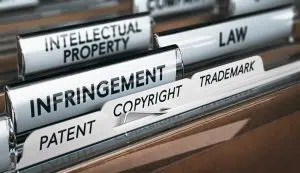 The difference between copyright and trademark is rooted in the protection they afford to different types of intellectual property.
The difference between copyright and trademark is rooted in the protection they afford to different types of intellectual property.
Copyright primarily safeguards original works of authorship, such as literary, artistic, and musical creations. This protection ensures that the creators have exclusive rights to reproduce, distribute, and display their work.
On the other hand, trademarks serve to protect symbols, names, phrases, and designs that distinguish goods or services in the marketplace. Trademarks play a crucial role in branding and preventing confusion among consumers regarding the source of products or services.
While copyright protects the expression of ideas, trademarks focus on protecting the identifiers that distinguish one business or product from another. In essence, copyright guards creative works, while trademarks safeguard the distinctive elements that build brand identity in the commercial landscape.
Copyright vs. trademark?
Intangible assets, such as inventions, literary and artistic works, designs, symbols, names, and images used in commerce, such as trademarks and copyrights, can both be defined as intellectual property.
The concept of intellectual property for businesses encompasses a wide range of issues, such as business ideas, works, and processes derived from them. In the U.S., intellectual property is legally protected by trademarks and copyrights as well as patents.
Despite both offering intellectual property protection, copyright and trademark protect different kinds of assets and are registered differently.
Book and video copyright is an automatic protection that is automatically generated when the work is created. For maximum legal protection, a trademark must be registered through the government and protects items like business logos and slogans that help define a brand.
Let’s break down each protection individually to better understand the differences.
What does a copyright protect?
Original works are protected by copyright, which is a form of intellectual property.
Works of literature, drama, music, and art are protected under copyright, including:
- Poetry
- Novels
- Other forms of original writing
- Art
- Research
- Movies
- Songs
- Other forms of audio and video materials
- Computer software
- Architecture
When a copyrighted work is created, it is protected as long as its original form is preserved. Conversely, works that cannot be copied are not copyrighted, such as speeches that were not recorded or written down.
The following works can’t be copyrighted:
- Ideas
- Discoveries
- Principles
- Lists of ingredients or contents (although a recipe or instructions can be protected by copyright)
- Calendars or charts showing weight and height are considered “common property.”
The public domain also prohibits copyrighting works that have expired, forfeited, or waived their copyrights. In the U.S., the public domain is currently defined as works published before 1923 (and sometimes works of different types).
As a result, copyright duration can vary in the U.S. Original works created by individuals are protected for their lifetime plus 70 years. Conversely, anonymous, pseudonymous (under a false name), and for hire works are protected by copyright for 95 years from publication or 120 years from creation, whichever comes first.
How to protect a copyright
In addition to the intellectual property that copyright, and trademarks protect, there is also a difference in their protection methods.
Several precautions can be taken, however, to make sure that potential copyright infringers don’t use your work without permission, as we’ve discussed throughout this lesson.
Examples include:
- Properly marking:Ensure that your work is properly marked, like signed or watermarked, and shows a clear link between your work and your business.
- Poor man’s copyright:This involves sending one’s own work to oneself, thus establishing ownership for a period of time. Copyright law does not provide for any such type of protection, and poor man’s copyright is not a substitute for registration.
- Creative Commons: Creative Commons offers free copyright licenses that let you mark your creative work with the freedoms you want it to carry.
- Use the copyright symbol:Use the © symbol to denote a copyrighted work.
Furthermore, although it is not required, you might decide to register your work with the U.S. Copyright Office. In order to officially register for your copyright, you must complete the application process—which includes paying a fee and sending a copy of the work to the U.S.
Once you complete this process, your copyright will be added to the public record, and you will receive a certificate of registration. It is also considered prima facie evidence in a court of law if registration is completed within five years of publication.
Under United States law, registering your copyright will make it much easier to sue if another party uses your materials without your permission.
What does a trademark protect?
By contrast, a trademark protects words, phrases, symbols, or designs that distinguish one brand (or source of goods) from another.
The following items are protected by trademarks:
- Brand names
- Logos
- Business names
- Slogans
As a result, distinguishing between a trademark and a service mark is crucial when it comes to trademarks. Service marks are used specifically to differentiate the services of one business from those of another, despite the term “trademark” being used to encompass both trademarks and service marks.
Although United Airlines may be trademarked, their slogan that defines their service, “Fly the Friendly Skies,” is a service mark.
In addition to all of this, one important difference between copyrights and trademarks is that copyrights expire after a set period, while trademarks do not.
In general, trademark rights are derived from actual use (e.g., using a mark for business purposes) and if you continue to use that mark, your trademark can last forever.
A trademark registration, however, provides the same level of legal protection as a copyright registration. Likewise, your trademark registration can also last forever if certain documents are filed, and fees are paid.
How to protect a trademark
Even though trademark registration is not necessary, it is a great way to ensure that your logo, brand name, or slogan is protected.
In order to ensure that your branding materials are not already in use, you should first conduct a trademark search. Furthermore, you can work with a trademark lawyer to assist with trademark registration, or you can submit an online application yourself if in the US through the U.S. Patent and Trademark Office (USPTO) website.
For example, if you wanted to register your business name as a trademark in the UK, you would check with the Intellectual Property Office (IPO) before completing the registration process. Additionally, it’s important to note that In the UK the Intellectual Property Office (UK IPO) is the government body that deals with trade mark registrations.
In addition, by filing a DBA with your state or county clerk, you can register a business name, but this is not the same as trademarking it.
To indicate that your property is legally trademarked, you’ll use the “®” registered trademark symbol if you register your trademark with the USPTO.
You can, however, use the TM symbol to signify common-law rights in a trademark if your trademark is not registered through the USPTO, similar to copyright law. TM refers to goods, while SM refers to services.
Remember, just because something doesn’t have a symbol by it does not mean it isn’t legally trademarked. Make sure your trademark isn’t already in use before using these symbols.
The main points to consider
Here is a summary of the differences:
- A trademark protects items that distinguish one business from another, whereas a copyright protects original work.
- The creation of original work automatically generates a copyright, while the use of a trademark in business establishes a trademark.
- When a trademark is used, it does not expire, unlike a copyright which expires after a set period.
Conclusion
In conclusion, the distinctions between copyright and trademark are crucial in protecting various forms of intellectual property. While copyright safeguards original works of authorship, such as literary, artistic, and musical creations, trademark focuses on protecting brand names, logos, and slogans associated with goods and services. Copyright provides exclusive rights to creators, granting them control over the reproduction and distribution of their works, while trademark safeguards a brand’s identity, ensuring its distinctiveness in the marketplace.
Understanding the disparities between copyright and trademark is vital for individuals, businesses, and artists seeking to safeguard their creations and establish a unique brand presence in a rapidly evolving global landscape. By utilizing these legal frameworks effectively, creators and businesses can secure their intellectual property rights and foster innovation and creativity in a fair and competitive environment.
Lee Jones is a seasoned Business Finance Specialist with over two decades of invaluable experience in the financial sector. With a keen eye for market trends and a passion for helping businesses thrive, Lee has become a trusted advisor to countless organizations seeking to navigate the complexities of finance.


